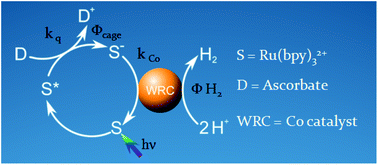Towards a comprehensive understanding of visible-light photogeneration of hydrogen from water using cobalt(ii) polypyridyl catalysts†
Abstract
Homogeneous aqueous solutions of photocatalytic ensembles, consisting of [Ru(bpy)3]2+ as a photosensitizer, ascorbic acid/ascorbate as the electron source, and 10 distinct Co2+-based molecular catalysts, were evaluated for visible-light induced hydrogen evolution using high-throughput screening. The combined results demonstrate that Co2+ complexes bearing tetradentate ligands yield more active photocatalytic compositions than their congeners with pentadentate ligands while operating with high catalyst stability. Additionally, molecular Co2+ catalysts with cis open coordination sites appear to be significantly more active for hydrogen evolution than those with trans open sites. As evidenced by mass spectrometric analysis of the reactor headspace and associated deuteration experiments, the H2 gas generated in all instances was derived from aqueous protons. One of the most promising cis-disposed Co2+ species, [Co(bpyPY2Me)(CH3CN)(CF3SO3)](CF3SO3) (1), engages in highly efficient hydrogen evolving photocatalysis, achieving a turnover number of 4200 (H2/Co) and a turnover frequency of 3200 (H2/Co per h) at pH 4 under simulated sunlight (AM 1.5G, 100 mW cm−2) at room temperature. At equimolar concentrations of photosensitizer and 1, the total hydrogen produced appears to be exclusively limited by the photostability of [Ru(bpy)3]2+, which was observed to decompose into an Ru(bpy)2–ascorbate adduct, as evidenced by HPLC and ESI-MS experiments. Lowering the operating temperature from 27 to 5 °C significantly attenuates bpy dissociation from the sensitizer, resulting in a net ∼two-fold increase in hydrogen production from this composition. The primary electron transfer steps of this photocatalytic ensemble were investigated by nanosecond transient absorption spectroscopy. Photoexcited [Ru(bpy)3]2+ undergoes reductive quenching by ascorbic acid/ascorbate (kq = 2.6 × 107 M−1 s−1), releasing [Ru(bpy)3]+ from the encounter solvent cage with an efficiency of 55 ± 5%. In the presence of catalyst 1, [Ru(bpy)3]+ generated in the initial flash-quench experiment transfers an electron (ket = 2 × 109 M−1 s−1) at an efficiency of 85 ± 10% to the catalyst, which is believed to enter the hydrogen evolution cycle subsequently. Using a combinatorial approach, all ten Co2+ catalysts were evaluated for their potential to operate under neutral pH 7.0 conditions. Catalyst 7, [Co(PY4MeH2)(CH3CN)(CF3SO3)](CF3SO3), was revealed to be most promising, as its performance metrics were only marginally affected by pH and turnover numbers greater than 1000 were easily obtained in photocatalytic hydrogen generation. These comprehensive findings provide guidelines for the development of molecular compositions capable of evolving hydrogen from purely aqueous media.


 Please wait while we load your content...
Please wait while we load your content...